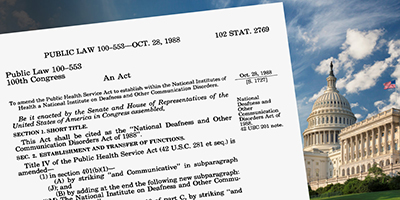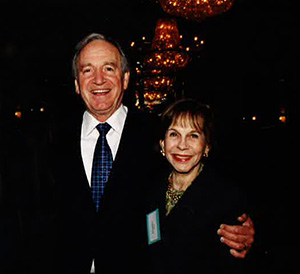Profiles of Pioneers Who Led the Way for the NIDCD

I want you to draft a bill.
Before establishing his own consulting firm, Peter Reinecke spent 20 years as a congressional staffer researching, providing briefings, and writing important legislation, largely around health and aging issues. He was research director for the House Subcommittee on Health and Long-Term Care, which was chaired by Representative Claude Pepper (D-FL) in the mid-1980s, when he was asked to join the congressman in a meeting with Geraldine Dietz Fox, a woman from Philadelphia who had recently lost hearing in one ear. At the meeting, Fox discussed the increasing prevalence of hearing loss in the U.S. and the need to boost NIH research on deafness and hearing loss.
After further discussion, Pepper, who had substantial age-related hearing loss and wore hearing aids in both ears, agreed to take up the cause. “He said, ‘Peter, I want you to draft a bill to create an ear institute at the NIH,’” says Reinecke. This was the start of both the legislation to establish the NIDCD and of a productive partnership between Reinecke and Fox.
“I took Mrs. Fox on as a partner … and she connected me with key experts in the field of otolaryngology,” says Reinecke. One of those experts was Robert Ruben, M.D., an otolaryngologist and researcher who was already actively advocating to Congress about the need for increased research in communication sciences. He would be instrumental in engaging key professional societies representing otolaryngology clinicians and researchers.
Over the next year, Reinecke, Fox, and Ruben met with scientists, health professional organizations, and people who were deaf or had hearing loss. Together, they created a bill that determined the scientific programs that would eventually become the NIDCD’s scientific mission areas: hearing, balance, taste, smell, voice, speech, and language.
Bipartisan and Diverse Support

Pepper found an ally in the Senate. Senate Tom Harkin (D-IA), whose brother, Frank, was deaf, also met with Fox. Through the combined efforts of Pepper and Harkin, the House and Senate developed companion legislation to establish the NIDCD. On September 29, 1987, Pepper introduced H.R.3361 while Harkin introduced S.1727–the National Deafness and Other Communications Disorders Act of 1988. Pepper and Harkin eventually got their respective bills passed. “By procedure, the House accepted S.1727, and this was the bill sent to President Reagan for signature,” says Reinecke.
“There was unusual bipartisan support—liberals, conservatives, moderates—from Congress for this bill,” recalls Reinecke. A diverse group of individuals with hearing loss—including professional athletes and actors as well as researchers and health care professionals—testified before Congress in support of establishing the NIDCD.
Academy Award-winning deaf actress Marlee Matlin was one of a handful of celebrities who testified in support of the bill. “Her testimony was significant in gaining support among senators for the bill,” says Reinecke.
The greatest champion, however, was Fox. Her one-on-one advocacy with members of both the House and the Senate, who ran the full spectrum of conservative to liberal, was critical. “It’s pretty amazing to have a ‘citizen champion’ like her,” says Reinecke. “She had that positive energy and perseverance. Everyone who knows Gerry just finds her a delight to be around.”
“If it weren’t for Mrs. Fox, this would have taken many more years,” adds Ruben.
There was unusual bipartisan support—liberals, conservatives, moderates—from Congress for this bill.
Significant Impact

After Pepper passed away in May 1989, Reinecke joined Harkin’s staff. In his new role, Reinecke was responsible for ensuring continued congressional support for the early years of the new institute. Harkin was a leading champion of medical research and for many years was chairman of the Senate panel responsible for funding both the NIDCD and the rest of the NIH. He led a successful effort to double NIH funding. Harkin retired in 2015, after serving in the Senate for 30 years.
Reflecting on the scientific progress made by the NIDCD in the 30 years since it was established, Reinecke says that the institute has “significantly impacted many people by improving technology for cochlear implants and hearing aids, educating people about protecting themselves from noise-induced hearing loss, and discovering possible ways to regenerate hair cells in the inner ear.”
“I know Congressman Pepper is smiling ‘up there,’ seeing what his handiwork has resulted in,” says Reinecke. “I also know that Senator Harkin feels the same way.”
Read more about the history of the NIDCD:

